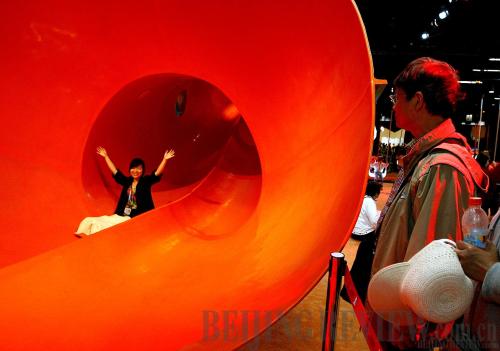|
 |
|
FAST TRANSPORTATION: A staff member at the Sweden Pavilion for the 2010 World Expo demonstrates how to take a slide ride from the second floor to the first floor (CHEN FEI) |
Sustainable cities
When asked about ideas and gadgets in the pavilion that are likely to have a great impact on people's lives, Rembe said, "the entire idea of developing urban areas from a holistic approach is very important."
She said highlighting the concept of sustainable cities is particularly important for China since the country is undergoing a massive urbanization process. "China doesn't have to repeat all the mistakes we made during our development," she said.
Examples of Sweden's own experience with environmental problems are shown in the Hall of Environmental Challenges. On one of the pop-up paintings, looking at it from one side, visitors can see heavily polluted water around Stockholm covered by a thick layer of algae until the 1960s. Looking at it from the other side, visitors can see a boy jumping into a lake in front of Stockholm city hall, which has become clean again thanks to the city's strict environmental policies.
Rembe said that colorful pipes painted on walls of the pavilion symbolize that everything in the city is connected and people need to have a holistic approach by combining the ecological, economical and social aspects of issues together to build a sustainable city.
"The pavilion itself is designed to be rebuilt and relocated and we also pay attention to small things, like using as little paper as possible in the pavilion," she said.
The pavilion embodies many of the sustainable practices that are on show in the exhibition to make it an environmentally friendly construction:
The outdoor atrium is constructed entirely from environmentally certified wood. The large wooden beams are made up of timber from young trees that are glue-laminated together. This way, no old-growth forests need to be harvested.
On the façade, the metal plating is coated with a special heat-reflective light-colored paint. "This means we use much less energy to keep it cool inside," Rembe said.
The entire structure can be moved and reused and the outer walls are made of reusable prefabricated modules.
The design of the pavilion was decided through a public competition. The winning design was submitted by one of Sweden's most renowned architecture firms, Sweco Architects. The pavilion is a 3,000 square-meter steel and wood structure made up of four cube-like parts that are arranged to form a cross-like space between them, a shape much like Sweden's flag when seen from above. These cubes are connected by elevated walkways and contain the exhibition, conference rooms, a shop, a café, and a large outdoor atrium.
The outer façade of the pavilion is made of perforated metal in a pattern that resembles a map of downtown Stockholm. The inner façade is decorated with scenes from Sweden's nature. This design symbolizes how, by balancing nature and city, urban and the rural people can lead a better life. |